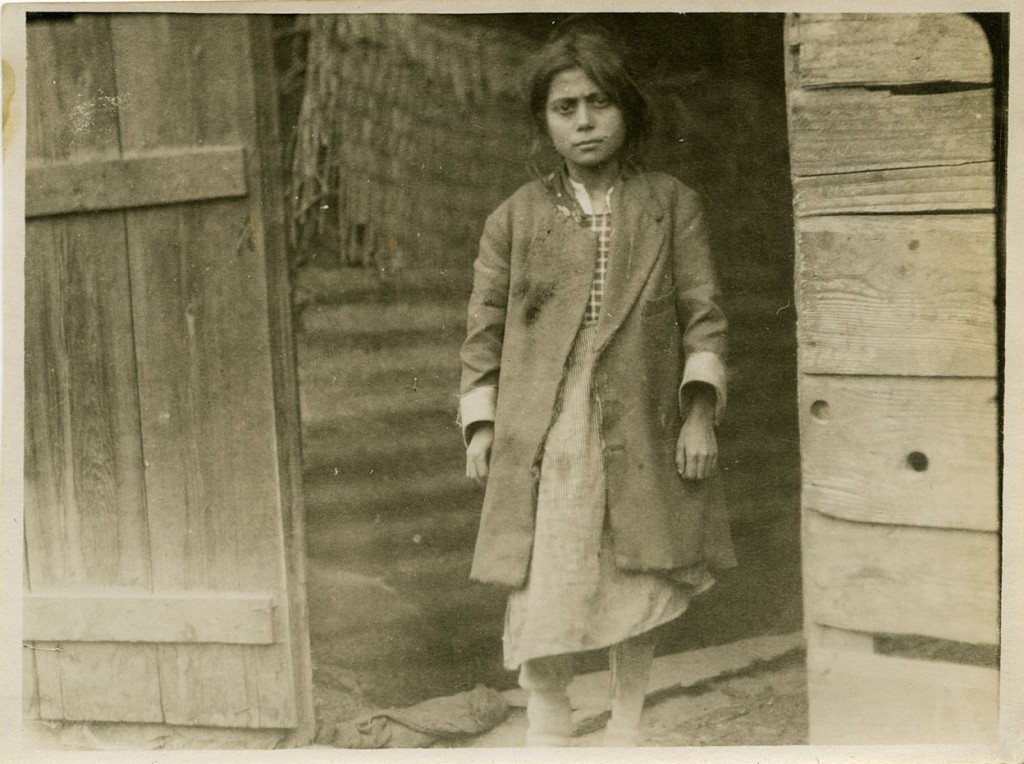Behind the Scenes: The Faces That Stay With You
In which your loyal curator plays favorites with the collection.

Photographer with refugee family. Caucasus region, 1920s.
Remember a few weeks ago, when we took a trip Behind the Scenes at the Digital Museum? It’s time for another venture backstage at the Near East Relief Historical Society. Ever since that Dispatch, I (your stalwart curator) have been thinking a lot about the questions that people ask me when they first learn about my job. The most common question by far is “just what is a digital museum?” Then there is a tie for second place:
“What drew you to this job?” and “Do you have a favorite object in the collection?”
Remember how I usually say that there is a long answer and a short answer for everything? Well, both of these questions have short answers. In fact, they have the same answer. Here it is:

Refugee girl, 1922.
Or rather, here she is. This young girl is the answer to both questions.
Before I was your loyal curator, I was a humble museum lover with a passion for storytelling. For me, museums are like the best possible time capsules — immersive environments where every single item tells a story. You leave feeling like you’ve traveled through time and space. Using objects to tell stories — photographs, paintings, personal artifacts, sculptures — is my favorite way to teach, and to learn.
As you may remember, when I started with the Near East Foundation I had almost no knowledge of the Armenian Genocide. I had eight months to catalog our image archives and create a Digital Museum that would rival an established museum collection on the subject. I launched myself into an in-depth exploration of NEF’s holdings at the Rockefeller Archive Center. It was an intellectual and emotional whirlwind. I did not yet have the historical knowledge to understand what I was looking at in the photographs. Without historical context, the photographs were utterly raw; and I was a blank slate for their messages. My emotions ran the gamut as I leafed through the fragile images.
And then I saw her. There she was, standing in a doorway in her tattered coat, her dark hair loose around her small, earnest face. She is a child, but her serious eyes could belong to an old woman. What have those eyes seen? What stories could this young girl tell us? Where did she come from? Behind her, we see a makeshift wall of corrugated metal and thatching. Is this her home? Does she have a family? There was no information written on the back of the photograph.

WHAT HAVE THESE EYES SEEN?
That enigmatic face haunted me. A few days later, I found her again. She was immediately recognizable: same bewitching eyes, same furrowed brow. She wears the same clothing. But this photograph is more of a portrait.
Small details become visible. Golden hoop earrings glint beneath the girl’s windblown hair. The thin line of a necklace peeks from beneath her shirt’s white collar. These tiny, beautiful things contrast harshly with the battered neckline of her coat. Perhaps they are souvenirs from a prior life — a life with a home, and a large family, and warm winter clothes. This second photograph is marked “1922.”
The two photographs have a professional quality to them, but Near East Relief dispatched photographers to many relief stations. The first picture is in a box that contains images with recognizable landmarks from Alexandropol and the Caucasus, and a few pictures that might be from Greece (remember, the collection has not been processed yet).
We can guess that this girl is not an orphan. She does not wear an orphanage uniform. It is quite uncommon to see the same child twice in our collection; furthermore, children were usually photographed in groups. This arresting little face clearly caught the photographer’s eye, just like it caught mine.
A SINGLE MOMENT
As you know, your loyal curator loves a good mystery. This young girl offers us an unparalleled mystery. But some mysteries cannot be solved. We may never know anything about this girl.
We see a snapshot from her life — a single moment from the middle of her story. Her life is a story with no beginning and no end.
I so wish that I could tell you more. But for now I am content to look at these two pictures, because for me, this young girl’s face embodies everything about the Near East Relief Historical Society’s work: in her face we see the bravery and resilience of survivors and refugees; the struggle to start a new life in a strange place; the pride, and dignity, and uncertainty that are inseparable from that struggle; the very real pain of survival.
It doesn’t matter that her story is incomplete. What matters is that we tell it.
THE NEAR EAST RELIEF HISTORICAL SOCIETY NEEDS YOUR SUPPORT!

Refugees in the Caucasus, 1920s.
